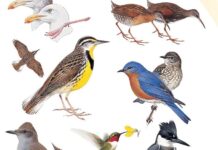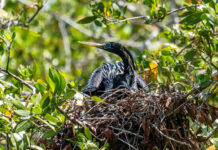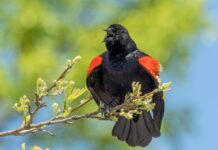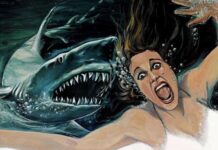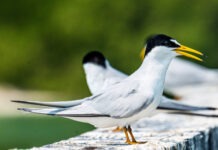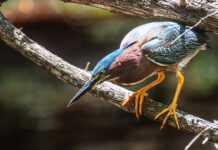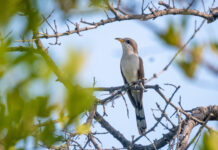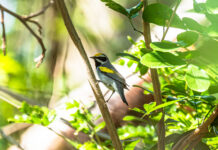There are two ways to look at summertime birdwatching in the Florida Keys. First, there aren’t many birds around, so it’s kind of boring. Second, there aren’t many birds around, so it’s a great time to start birdwatching.
A little over 800 species of birds have been recorded in North America. About 350 of those have been seen in the Florida Keys, which is loosely defined as everything from the 18-Mile Stretch down to Key West. (If you define the Florida Keys as Monroe County, then a large chunk of it is the Everglades, a whole different — alligator-filled — ballgame.)
Of those 350 species, about 70 can be seen pretty readily year-round if you spend a bit of time outdoors. Seventy species may seem like a lot, but not if you break them up into smaller, more easily identifiable groups – ducks, gulls, songbirds, chickens, etc.
(Birding in the summer is a great way to get your footing, but it’s best to do it in the morning or late afternoon to avoid the heat, unless you like the dizzy, de-energized feeling that comes from the relentless noonday sun.)
Herons and egrets —creatures of shallow waters and shorelines — are a great starting point for beginners. We have a lot of them. Also, they’re rather large, easy to find and not too difficult to tell apart. A field guide really helps, but this list should narrow down the possibilities.
Great blue heron
Approximately 4 feet tall, it’s the tallest bird you’ll see in the Keys. It’s got a solid, railroad spike of a bill, and plumage that is primarily a slaty blue, but with a whitish face and a black crown. Their range is all over North America, stretching down through Mexico and Central America. You see them most often standing statue-like on the shore, as if posing for a postage stamp photo, but they’ll occasionally be flying or hunting for fish in the flats.
Great white heron
The great white heron only occurs in the Florida Keys and extreme South Florida. They are officially considered a subspecies of the great blue heron, but that could change, depending on how the folks at the American Ornithological Society define a species. Many people call the great white heron the wordier, more technically correct, “great blue heron, white color morph.” (That’s how it’s listed on most checklists.) But they’re a hometown bird, and I’m rooting for them to be considered their own species again, so I always refer to them as great whites. They are essentially the same size and shape as the great blue, with the same railroad spike bill, but their plumage is all white, as if they’re wearing a fancy tuxedo from the ’80s. It’s difficult to confuse them with any other species … except the…
Great egret
The great egret is also a tall, all-white wading bird that hangs around in similar habitats as the great white heron. It’s about two-thirds the size of a great white, though that’s not a great field mark if they’re not standing next to each other. They also have an overall slimmer build and less hefty bill, all of which doesn’t necessarily inspire confidence if you’re trying to make an ID, especially when you’re first starting out. So here’s the cheat: Great white herons have pale, tannish legs. Great egrets have black legs. They are a pretty cosmopolitan species, found not just in North and South America, but also in all the A continents – Asia, Australia, and Africa.
Snowy egret
Another all-white wading bird, the snowy egret is two-thirds the size of the great egret. They give the impression of a slighter build, and often have a few longer plume feathers hanging off the back of their head like a cowlick.
They’re usually in the company of other snowy egrets, but sometimes are seen solo. They’re denizens of the lower half of North America, the Caribbean and nearly all of South America. Their dark legs and yellow feet, a.k.a. golden slippers, are the easiest way to identify them.
Reddish egret
Reddish egrets come in two flavors (properly called color phases) — the reddish/mauve of their name, and white. There is no in-between. It’s an either/or situation. The mauve ones are easy. The white ones take a little more attention. They are bulkier than snowy egrets – linebackers, compared to running backs. But the adults have two-toned bills, pinkish toward the face, dark toward the outer tip. Also, if you see a bird dancing like a freak in the shallows, it’s a reddish.
Tri-colored heron
I generally clue into tri-colored herons because they’re the skinniest of the herons. Their necks are so long and so thin, I wonder how they can be functional. They actually do have a three-colored plumage when young, though when they mature, it is more like four colors. The biggest clue is their white belly and the heavily contrasting dark breast, neck and wings. I do, on occasion, see a lone tri-color, but over the last few years I’ve seen them in groups of five to 40 birds.
Little blue heron
Little blue herons were named simply as if they’re the small version of the great blue heron, but they have their own thing going on. They’re only 2 feet tall, with a more compact build. From a great distance it’s possible to confuse them with a reddish, but they skew more towards the dark blue end of color spectrum, as opposed to reddish/mauve. And they are smaller. They are white for the first year of their life, and you could confuse them with a white-phase reddish egret, but again it comes down to the legs – little blues have yellow/green legs, and the reddish have dark gray legs. Little blues also undergo an amazing phase: When they transition from juvenile to adult, their plumage is a patchwork of blue and white.
Green heron
The smallest of the herons in Keys, green herons are shapeshifters, looking sometimes like a no-necked bowling pin, and sometimes like a thick-necked, avian relative of the giraffe. It depends on their mood and activity. You generally see them hunting from low branches in the mangroves. But you also see them hunting from dock lines in marinas and other opportunistic perches. Sometimes they’ll actually drop a small twig into the water and wait for a fish to come investigate, only to get snatched up. You have to love a bird that knows how to use tools.














